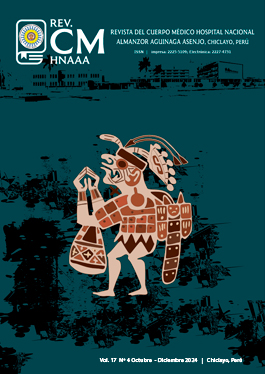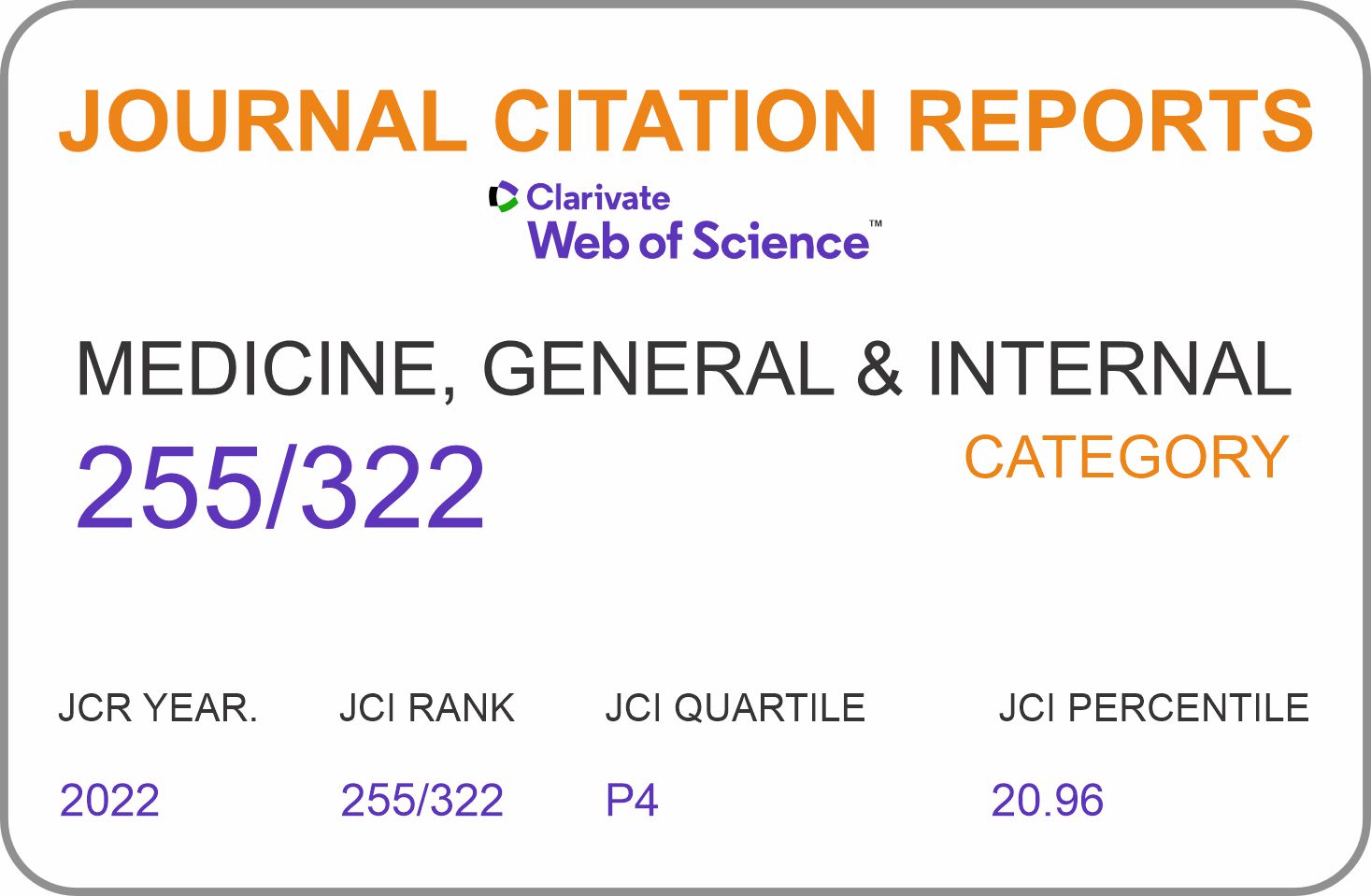Antibiotic resistance of the most common bacteria isolated in blood cultures. Neonatal intensive care unit. Hospital III-1. Chiclayo, Perú 2020-2021
DOI:
https://doi.org/10.35434/rcmhnaaa.2024.174.2425Keywords:
Antibiotic Resistance, Blood Culture, Bacteria, Intensive Care Units, NeonatalAbstract
Introduccion: Bacterial resistance to antibiotics is associated with increased morbidity and mortality. Objective: Determine the antibiotic resistance of the most common bacteria isolated in blood cultures in a Neonatal Intensive Care Unit. Materials and methods: Descriptive – retrospective, the identification of bacteria was done with VITEK XL, the susceptibility was done with the CLSI M100 guidelines. 30 edition. Results: The antibiotic resistance of the isolated bacteria was: Imipenem 15.6%, Meropenem 14.3%, Piperacillin/tazobactam 9.4%, Vancomycin 8.5%, Colistin 7.7%, Quinupristin/dalfopristin 7.1%, Amicacin 6.7%, Linezolid 2.7%. Tigecycline, Nitrofurantoin, Ertapenem, Tobramycin, Chloramphenicol, Streptomycin, Gentamicin had 0% resistance. The ECN had resistance to vancomycin 7.9%, Quinupristin/dalfopristin (6.4%), Linezolid (2.8%). Tigecycline, Nitrofurantoin, Doxycycline and Chloramphenicol had 0% resistance. Klebsiella pneumoniae: 0% resistance to Amicacin, meropenem, gentamicin, tigecycline, ertapenem, imepenem, colistin and piperazine/Tazobactan. Acinetobacter baumannii: 0% antibiotic resistance, for Gentamicin, Ciprofloxacin, Tigecycline, Colistin, Levofloxacin and Tobramycin. Conclusion: The antibiotics with 0% resistance to all bacteria were Tigecycline, Nitrofurantoin, Ertapenem, Doxycycline, Tobramycin, Chloramphenicol, Tobramycin, Chloramphenicol, Gentamicin.
Downloads
Metrics
References
Fernández-Díaz N, Duque de Estrada-Riverón J, Díaz Cuéllar F. Morbilidad y mortalidad por sepsis neonatal precoz. Rev Cubana Pediatr [Internet]. 2010 Jun [citado 2024 Mar 07] ; 82( 2 ). Disponible en: https://surl.li/rqruum
Wang J, Zhang H, Yan J, Zhang T. Literature review on the distribution characteristics and antimicrobial resistance of bacterial pathogens in neonatal sepsis. J Matern Fetal Neonatal Med. 2022;35(5):861-870. doi: 10.1080/14767058.2020.1732342
Organización Mundial de la Salud. Sobrevivir y prosperar: transformando la atención para cada recién nacido pequeño y enfermo. Organización Mundial de la Salud. 2019 [Citado el 05 de enero del 2025]. Disponible en: https://surl.li/vwdvdz
Dharmapalan D, Shet A, Yewale V, Sharland M. Altas tasas reportadas de resistencia a los antimicrobianos en infecciones del torrente sanguíneo neonatales y pediátricas de la India. J Pediátrico Infecta Dis Soc. 2017;6(3):e62-e68. doi: 10.1093/jpids/piw092
Naghavi M, Abajobir AA, Abbafati C, Abbas KM, Abd-Allah F, Abera SF, et al. Global, regional, and national age-sex specific mortality for 264 causes of death, 1980–2016: a systematic analysis for the Global Burden of Disease Study 2016. The Lancet. 2017;390(10100):1151–210. doi: 10.1016/S0140-6736(17)32152-9.
Grupo Interinstitucional de las Naciones Unidas para la Estimación de la Mortalidad Infantil: Informe sobre el nivel y las tendencias de la mortalidad infantil 2019. En.; 2019. https://surl.li/gejqfl
Global Burden of Disease, 2015 Child Mortality Collaborators. Global, regional, national, and selected subnational levels of stillbirths, neonatal, infant, and under-5 mortality, 1980-2015: a systematic analysis for the Global Burden of Disease Study 2015 [published correction appears in Lancet. 2017;7;389 (10064):e1]. Lancet 2016;388(10053):1725–74 doi: 10.1016/S0140-6736(16)31575-6
Zamarano H, Musinguzi B, Kabajulizi I, et al. Bacteriological profile, antibiotic susceptibility and factors associated with neonatal Septicaemia at Kilembe mines hospital, Kasese District Western Uganda. BMC Microbiol. 2021;21(1):303. doi: 10.1186/s12866-021-02367-z.
Laxminarayan R, Matsoso P, Pant S, Brower C, Røttingen JA, Klugman K, et al. Access to effective antimicrobials: a worldwide challenge. Lancet Lond Engl. 2016;387(10014):168-75. doi: 10.1016/s0140-6736(15)00474-2
Sorsa A, Früh J, Stötter L, Abdissa S. Blood culture result profile and antimicrobial resistance pattern: a report from neonatal intensive care unit (NICU), Asella teaching and referral hospital, Asella, south East Ethiopia. Antimicrob Resist Infect Control. 2019;20;8:42. doi: 10.1186/s13756-019-0486-6
Levy MM, Artigas A, Phillips GS, Rhodes A, Beale R, Osborn T, et al. Outcomes of the Surviving Sepsis Campaign in intensive care units in the USA and Europe: a prospective cohort study. Lancet Infect Dis. 2012;12(12):919-24. doi: 10.1016/s1473-3099(12)70239-6
Blevins SM, Bronze MS. Robert Koch and the “golden age” of bacteriology. Int J Infect Dis 14:e744 – e751. doi: 10.1016/j .ijid.2009.12.003.
Kreger BE, Craven DE, Carling PC, McCabe WR. Gram-negative bacteremia. III. Reassessment of etiology, epidemiology and ecology in 612 patients. Am J Med 68:332–343. doi: 10.1016/0002-9343(80)90101-1
Ilstrup DM, Washington JA, II. 1983. The importance of volume of blood cultured in the detection of bacteremia and fungemia. Diagn Microbiol Infect Dis 1:107–110. doi: 10.1016/0732-8893(83)90039-1.
Herbozo C, Julca I, Flores F, Hernandez R, Zegarra J. Incidence and microbiological characteristics of neonatal late onset sepsis in a neonatal intensive care unit in Peru. Int J Infect Dis. 2021;108:171-175. doi: 10.1016/j.ijid.2021.05.012
Zamora LL, González AC, Cruz RE, Cordóvez MDC. Etiología y perfil de susceptibilidad antimicrobiana en sepsis neonatal. Revista Eugenio Espejo , vol. 16 , núm. 1 , págs. 4-17 , 2022. doi: 10.37135/ee.04.13.02
Taylor SP, Anderson WE, Beam K, Taylor B, Ellerman J, Kowalkowski MA. The Association Between Antibiotic Delay Intervals and Hospital Mortality Among Patients Treated in the Emergency Department for Suspected Sepsis. Crit Care Med. 2021;49(5):741-747. doi: 10.1097/ccm.0000000000004863
Flannery DD, Chiotos K, Gerber JS, Puopolo KM. Neonatal multidrug-resistant gram-negative infection: epidemiology, mechanisms of resistance, and management. Pediatr Res. 2022;91(2):380-391. doi: 10.1038/s41390-021-01745-7
Eshetu B, Gashaw M, Solomon S, Berhane M, Molla K, Abebe T, et al. Bacterial Isolates and Resistance Patterns in Preterm Infants with Sepsis in Selected Hospitals in Ethiopia: A Longitudinal Observational Study. Glob Pediatr Health. 2020;3;7:2333794X20953318. doi:10.1177/2333794x20953318
Pokhrel B, Koirala T, Shah G, Joshi S, Baral P. Bacteriological profile and antibiotic susceptibility of neonatal sepsis in neonatal intensive care unit of a tertiary hospital in Nepal. BMC Pediatr. 2018;27;18(1):208. doi: 10.1186%2Fs12887-018-1176-x
Raghubanshi BR, Sagili KD, Han WW, Shakya H, Shrestha P, Satyanarayana S, et al. Antimicrobial Resistance among Neonates with Bacterial Sepsis and Their Clinical Outcomes in a Tertiary Hospital in Kathmandu Valley, Nepal. Trop Med Infect Dis. 2021;20;6(2):56. doi: 10.3390/tropicalmed6020056
Nebbioso A, Ogundipe OF, Repetto EC, Mekiedje C, Sanke-Waigana H, Ngaya G, et al. When first line treatment of neonatal infection is not enough: blood culture and resistance patterns in neonates requiring second line antibiotic therapy in Bangui, Central African Republic. BMC Pediatr. 2021; 13;21(1):570. doi: 10.1186/s12887-021-02911-w
Pillay D, Naidoo L, Swe Swe-Han K, Mahabeer Y. Neonatal sepsis in a tertiary unit in South Africa. BMC Infect Dis. 2021;27;21(1):225. doi: 10.1186/s12879-021-05869-3
Bielicki JA, Sharland M, Heath PT, Walker AS, Agarwal R, Turner P, et al. Evaluation of the Coverage of 3 Antibiotic Regimens for Neonatal Sepsis in the Hospital Setting Across Asian Countries. JAMA Netw Open. 2020; 5;3(2):e1921124. doi: 10.1001/jamanetworkopen.2019.21124
Mohakud NK, Mishra JP, Nayak MK, Mishra J, Pradhan L, Panda SS, et al. Bacteriological Profile and Outcome of Culture-Positive Neonatal Sepsis in a Special Newborn Care Unit Setting, Odisha. Cureus. 2022; 31;14(5):e25539. doi: 10.7759/cureus.25539
Candel FJ, Borges Sá M, Belda S, Bou G, Del Pozo JL, Estrada O, et al. Current aspects in sepsis approach. Turning things around. Rev Esp Quimioter [Internet]. 2018 [Cited 2024 Dec 12];31(4):298-315. Available from: https://surl.li/dgrgve
Ba-Alwi NA, Aremu JO, Ntim M, Takam R, Msuya MA, Nassor H, et al. Bacteriological Profile and Predictors of Death Among Neonates With Blood Culture-Proven Sepsis in a National Hospital in Tanzania-A Retrospective Cohort Study. Front Pediatr. 2022;5;10:797208. doi: 10.3389/fped.2022.797208
Morosini MI, Cercenado E, Ardanuy C, Torres C. Detección fenotípica de mecanismos de resistencia en microorganismos Grampositivos. Enferm Infecc Microbiol Clin. 2012; 30(6):325–332. doi: 10.1016/j.eimc.2011.09.009
Almohammady MN, Eltahlawy EM, Reda NM. Pattern of bacterial profile and antibiotic susceptibility among neonatal sepsis cases at Cairo University Children Hospital. J Taibah Univ Med Sci. 2020;4;15(1):39-47. doi: 10.1016/j.jtumed.2019.12.005
Van Staaden H, Hendricks C, Spicer K. Bacteraemia and antibiotic sensitivity in a tertiary neonatal intensive care unit. S Afr J Infect Dis. 2021;5;36(1):195. doi: 10.4102%2Fsajid.v36i1.195
Cercenado E, Saavedra-Lozano J. El antibiograma (II): fenotipos de resistencia y lectura interpretada. An Pediatría Contin. 2009;7(5):282-7. doi: 10.1016/j.acci.2020.09.006
Jiménez Pearson MA, Galas M, Corso A, Hormazábal JC, Duarte Valderrama C, Salgado Marcano N, Ramón-Pardo P, et al. Consenso latinoamericano para definir, categorizar y notificar patógenos multirresistentes, con resistencia extendida o panresistentes. Rev Panam Salud Publica. 2019;22;43:e65. Spanish. doi: 10.26633%2FRPSP.2019.65
Yılmaz Fatma H, Gültekin Nazlı D, Tarakçı Nuriye, Altunhan Hüseyin. Nuestra experiencia con el tratamiento con tigeciclina en tres recién nacidos que presentaban septicemia por Klebsiella pneumoniae. Arch. argent. pediatr. [Internet]. 2018 Ago [citado 2024 Feb 19] ; 116( 4 ): e648-e648. Disponible en: https://surl.li/tqdvxm
Downloads
Published
How to Cite
Issue
Section
Categories
License
Copyright (c) 2025 Jorge Luis Sosa-Flores, Juan Fernando Chapoñan-Mendoza

This work is licensed under a Creative Commons Attribution 4.0 International License.















